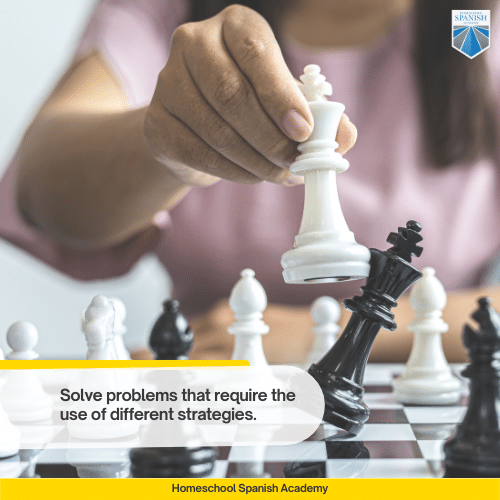
7 Simple Study Methods for Middle and High School Students
Looking for study methods and options for your middle or high schooler?
There are many study methods out there, and each one provides students with different benefits and approaches and finding the right one for your children is crucial to helping them navigate their education.
Keep reading to discover why it’s essential to develop a study habit and learn 7 study methods for middle and high school students.
Who Is Homeschool Spanish Academy?
We’re an online Spanish school committed to empowering parents and their children to live happier lives, enjoy stronger learning outcomes, and experience real success. Learn more about our classes. ➡️
The Importance of Developing a Studying Habit
Let’s be honest, adolescence is a mess!
To be a teenager is to be a confused human being with lots of questions and few answers—all the while experiencing a hormonal roller coaster and constant physical changes.
Add to that the new world that opens up for teenagers, their enhanced social life, and all the distractions available nowadays for them. So it’s no wonder that many of them struggle in school.
That’s why we, as parents, need to help them develop studying habits. Keep in mind that they’ll be ready for university if they have strong studying skills.
7 Useful Study Methods
The following is a list of the 7 best study methods and techniques I’ve found and used with my middle and high school students.
1. Efficient Note-Taking
It may sound tedious. But I can’t stress just how important it is to take efficient notes during a lesson.
Students are used to copying everything they see on the board with the foolish idea that they will re-read it and study it “later.” Needless to say, “later” never becomes a reality. A big reason is that notes are boring and completely useless.
There are different techniques to create attractive notes and improve their efficiency. So I recommend students try several until they find one that better fits their learning style.
Research has shown that “taking notes by hand is more effective than typing on a laptop.”

Here you have some note-taking techniques that every middle and high school student should consider:
- Bullet System: Sometimes, instead of copying everything the teacher wrote down or said, it’s better to synthesize the concept expressed in a bullet point.
- Cornell Note Taking Method: Divide a page into three sections, as shown in the image below. Then in the note-taking area, record the lesson as fully as possible. Then reduce your notes to shorter ideas in the cue column. Finally, write a recap of each page using only one or two sentences.
- Use Drawings, Charts, and Graphs: There’s no reason you should limit yourself to written notes. Instead, add useful drawings, design graphs, create map minds, use thought bubbles. In other words, get creative!

2. Say No to Multitasking
Multitasking is a sign of the times we live in. Not only students do this, but professionals from very different areas suffer from this same issue. Even writers like me.
But what is multitasking?
Multitasking is when “someone tries to perform two tasks simultaneously, switching from one task to another; or perform two or more tasks in rapid succession.” Imagine your children are trying to study for a test while checking their social media accounts, chatting with their friends on WhatsApp, and watching Tik-Tok videos.
Impossible!
Research has shown that multitasking makes us “less efficient and more likely to make a mistake.” So, the recommendation is to study less but with greater intensity.
If your children study 3 hours for a test, with all kinds of distractions at hand, it’s time to stop. Ask them instead to study for only one hour, but completely disconnected from the outside world and focused only on studying.
3. Spaced Repetition
The German psychologist Herman Ebbinghaus came up with this method. He based his research on “the process of retaining information and forgetting it.”
This technique helps your child learn new topics and put them to practice “intuitively and accurately.” The idea is kids learn better by letting longer periods of time pass between studying sessions.
Create your own child’s schedule to apply spaced repetition. Here you can find a valuable and thorough example of how to do it.
You can also use Anki and SuperMemo to help your child improve their learning.
Hear Your Child Speak Spanish! Your Free Trial Class Is Waiting ➡️
4. Organize, Organize, Organize
One of the main problems kids face when trying to study is a lack of organization.
They might put in the effort and time, but due to a terrible organization, the effectiveness of the child’s studying time won’t be good.
There are many ways to help your child organize his working area and studying efforts. Every little thing that organizes time, space, and information, is beneficial to your child.
I suggest you try the following:
- Schedule your child’s studying time
- Use colorful highlighters to categorize information
- Use a planner to track their homework
- Setting clear goals
- Design a daily studying routine
It’s also important to design an organizational system for the materials your children might use.
“What materials?” you may ask.
A 3-ring binder, and colorful folders for different subjects, for example, are also great for improving your child’s studying skills.
5. Teach the Lesson to Another Student
I got this tip from my math high school teacher, adopted it instantly, and used it throughout my university years. It was infallible! As a teacher, this is the first studying method I recommend to my students.
When you teach any subject, you then own the content. So, naturally, you first need to understand and summarize the information. Encourage your children to look for a study buddy or a group of classmates with different subjects of expertise.
Perhaps your kids are good at math, and they know someone who is great in Spanish.
6. Interleaved Practice
Interleaved practice is one of the best ways to study math, although it isn’t the most typical.
This studying method says that kids shouldn’t solve problems from the immediately preceding lesson. They should, instead, try to solve problems that require the use of different strategies (addition, subtraction, multiplication, and division).
This way, students repeat what they learned in the previous lesson. Also, they must choose a strategy to resolve the problem itself, just like they must do in a real test.
Research shows that interleaved practice improves mathematics learning.
It also “provides students with an opportunity to learn how to choose an appropriate strategy and a chance to practice the skill they are expected to learn.”

7. Pomodoro Technique
The Pomodoro Technique is “a time management method meant to increase focus and concentration.”
You first need to make a to-do list and then set a timer for 15 to 25 minutes. Now, focus only on the first task in your list until the timer goes off. Repeat this process four times and then take a 5-minute break. This allows the information to sink in and your mind to clear itself.
You can then start the cycle again if you need to.

Choosing the Right Studying Method Can Help Your Child Improve Academically
Sometimes all students need to improve their grades is to find a studying technique that suits them and their needs. I encourage you to try several of the studying methods discussed above to find the right fit for your middle or high school child.

Join one of the 40,000 classes that we teach each month and you can experience results like these…

“This is the best way for your kid to learn Spanish. It’s one-on-one, taught by native Spanish speakers, and uses a curriculum.”
– Sharon K, Parent of 3

“It’s a great way to learn Spanish, from native Spanish speakers in a 1-on-1 environment. It’s been fairly easy to schedule classes around my daughter’s other classes. The best value for us has been ordering multiple classes at a time. All the instructors have been great!”
– Cindy D, Parent of 3

“HSA offers very affordable, quality, one on one classes with a native speaker. My son has greatly benefited from taking classes. We have seen his confidence increase as well as his pronunciation improve, because he learns from a native Spanish speaker. HSA has quick, personal customer service. Our family has been very pleased with our experience so far!”
– Erica P. Parent of 1
Want more super useful education-related content? It’s for you!
- 10 Homeschooling Styles You Need to Explore in 2023
- Local Learning Networks: Finding Homeschool Co-ops Near You
- Home Sweet Classroom: Creating Engaging Spanish Lessons at Home
- 10 Websites Offering Short Stories in Spanish for Beginners
- Can Homeschoolers Participate in Sports?
- 10 Tips for When Homeschool Isn’t Working
- Is There Homeschooling in Latin America?
- 10 Productive Back-to-School Activities for Your Spanish Class
- Language Learning with Netflix: How to Use the Chrome Extension - April 18, 2024
- 23 Common Spanish Prepositions You Can Use Today - March 27, 2024
- 25 Common Subjunctive Phrases in Spanish Conversation - March 21, 2024





